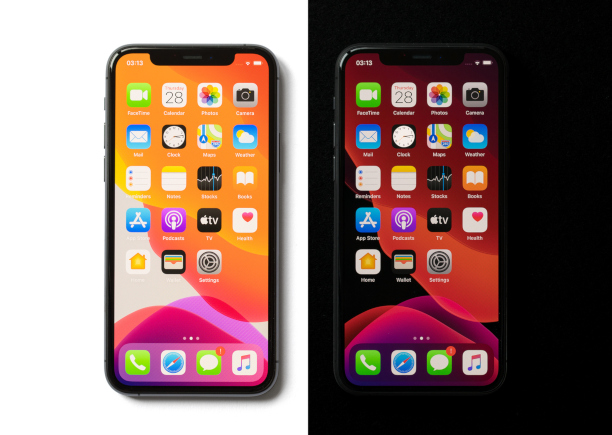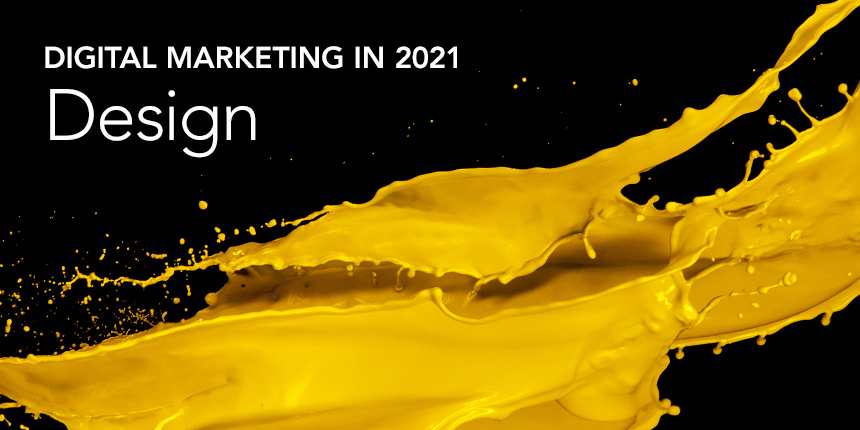Like every digital discipline, design is being steadily reshaped by the “new normal”. Although users may yearn for the beforetimes—familiar click paths, comforting colors—the pandemic has changed the way they interact online, and accelerated a number of long-expected UX/UI advancements.
Ready to get to grips with VUI, AR, microinteractions, and more? Then you’ve come to the right place. Let’s run through the five design developments every marketer needs to know about in 2021.
-
Hello dark mode, my old friend
Okay, dark mode has existed since the early 2010s, but it did not gain much traction until the mid-2010s. Nowadays, it is common for apps have a dedicated light/dark mode toggle—and now that big players like Google, Samsung, Facebook, and Apple have consistently implemented dark mode into their apps and sites, it is more or less an industry standard.
Dark mode saves device battery power on OLED/AMOLED screens as it doesn’t require a backlight. Dark pixels save power as OLED screens use black backdrops as the default and “turns on” pixels to add color and brightness. With OLED displays becoming more common (the iPhone X, XS, and XS max come with it, as do many Samsung devices), dark mode’s perks are becoming more noticeable.

From a design perspective, dark mode can be leveraged by brands for its sleek, modern aesthetic. For instance, colors pop more when they are set against a darker background. But this isn’t simply a case of vibrant designs; there are UX considerations, too.
When designing for dark mode, pay close attention to typography. Although claims that dark mode reduces eye strain are debated, research suggests that dark text on a light background is more legible regardless of age group—and there might be some truth to the claim that dark mode is better for evening browsing as it reduces the level of blue light. Either way, expect dark mode to proliferate this year.
-
Hey Google, what’s “VUI”?
The widespread adoption of smart home devices such as Nest, Google Assistant, Amazon Alexa, and Siri is showing no signs of slowing. By 2023, in fact, the smart home market—constituting the sales of networked devices and related services—is forecast to be worth more than £103 billion.
Other eye-popping statistics include:
- Google Speech Recognition technology has a 95% accuracy rate in those regions where English is widely spoken
- 55% of teenagers are using voice search daily basis.
- 50% of searches will be done without a screen or a keyboard by 2021
As far as marketers are concerned, new and different user interfaces (UI) are needed for voice commands, incorporating not only phones and computers but also car HUDs and smart appliances.
Therein lies the challenge, with voice user interfaces (VUI) coming with their own unique user flows and pain points. For example, unintuitive onboarding and setup can be a strong deterrent for those unfamiliar with voice commands. Until VUI patterns become more commonplace, designers need to lead and teach users how to navigate through a relatively new world.
-
Expect more VR and AR breakthroughs
Virtual reality (VR) and augmented reality (AR) are booming in gaming, and will likely make strides towards more mainstream applications in 2021. Apple, for instance, is working on a number of AR initiatives, including digital glasses that connect wirelessly to an iPhone in order to beam content to the user. It’s just one of many developments that will cause the global market for AR products to surge 85% to £121 billion in the next four years.

Consider also that AR is taking on new importance in an increasingly remote world. There are already some great examples of brands innovating when faced with local lockdowns and other restrictions, including:
- A Warby Parker app that allows customers try on glasses
- The IKEA Place app, which enables customers to virtually place furniture in their home
- InkHunter, which lets you see what a tattoo will look like on your skin
-
Mind your Ps, Qs, and microcopy
The world of storytelling and brand narratives is set to take on new importance in 2021. After all, it makes brands memorable and relatable, which in turn drives user loyalty and retention.
But standard corporate language is failing to resonate with younger users, who increasingly expect to engage with more personable and familiar phrasing. Where appropriate, brand copywriters should be empowered to use levity, informality, and even colloquialisms to better engage and compel users.
And don’t forget microcopy! The language chosen for calls to action, buttons, and menus is much more important than the tiny character count may otherwise suggest. Microcopy is the point at which users interact with any given digital asset, and brands that pay close attention (take a bow, Wealthsimple!) are set to reap the rewards this year.
-
The year of the microinteraction
On a related note, we’re fully expecting microinteractions to finally be afforded the respect they deserve in 2021. These small moments exist to not only make user goals more fluid and accessible, but to delight users by creating interactions that are engaging, welcoming, and human.
Typical examples of microinteractions include tooltips, progress/loading bars, and swipe interactions—all of which keep users engaged and informed with non-intrusive animations and other visual cues. Designers have to pay close attention to these small-but-significant assets, which should ultimately:
- Provide users with instant feedback from their actions
- Communicate to users the status of something
- Encourage sharing and content engagement
- Improve navigation and direct users to be more focused
How will the next 12 months unfold in digital marketing? From design to media, content, analytics, and more, take a glimpse into the future with our free 2021 predictions PDF!




